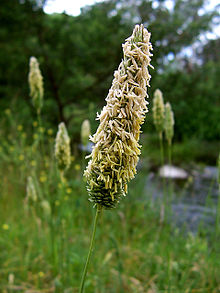 Global Information
Global InformationPoaceae information
| Grasses Temporal range: [1]
| |
|---|---|

| |
| Flowering head of meadow foxtail (Alopecurus pratensis), with stamens exerted at anthesis | |
| Scientific classification | |
| Kingdom: | Plantae |
| Clade: | Tracheophytes |
| Clade: | Angiosperms |
| Clade: | Monocots |
| Clade: | Commelinids |
| Order: | Poales |
| Clade: | Graminid clade |
| Family: | Poaceae Barnhart[2] |
| Type genus | |
| Poa L.
| |
| Subfamilies | |
| |
| Synonyms[3] | |
|
Gramineae Juss. | |
Poaceae (/poʊˈeɪsiaɪ, -siːiː/) or Gramineae (/ɡrəˈmɪniaɪ/) is a large and nearly ubiquitous family of monocotyledonous flowering plants commonly known as grasses. It includes the cereal grasses, bamboos, the grasses of natural grassland and species cultivated in lawns and pasture. The latter are commonly referred to collectively as grass.
With around 780 genera and around 12,000 species,[4] the Poaceae is the fifth-largest plant family, following the Asteraceae, Orchidaceae, Fabaceae and Rubiaceae.[5]
The Poaceae are the most economically important plant family, providing staple foods from domesticated cereal crops such as maize, wheat, rice, barley, and millet as well as feed for meat-producing animals. They provide, through direct human consumption, just over one-half (51%) of all dietary energy; rice provides 20%,[6] wheat supplies 20%, maize (corn) 5.5%, and other grains 6%.[citation needed] Some members of the Poaceae are used as building materials (bamboo, thatch, and straw); others can provide a source of biofuel, primarily via the conversion of maize to ethanol.
Grasses have stems that are hollow except at the nodes and narrow alternate leaves borne in two ranks. The lower part of each leaf encloses the stem, forming a leaf-sheath. The leaf grows from the base of the blade, an adaptation allowing it to cope with frequent grazing.
Grasslands such as savannah and prairie where grasses are dominant are estimated to constitute 40.5% of the land area of the Earth, excluding Greenland and Antarctica.[7] Grasses are also an important part of the vegetation in many other habitats, including wetlands, forests and tundra.
Though they are commonly called "grasses", groups such as the seagrasses, rushes and sedges fall outside this family. The rushes and sedges are related to the Poaceae, being members of the order Poales, but the seagrasses are members of the order Alismatales. However, all of them belong to the monocot group of plants.
- ^ Yan Wu; Hai-Lu You; Xiao-Qiang Li (2018). "Dinosaur-associated Poaceae epidermis and phytoliths from the Early Cretaceous of China". National Science Review. 5 (5): 721–727. doi:10.1093/nsr/nwx145.
- ^ Angiosperm Phylogeny Group (2009). "An update of the Angiosperm Phylogeny Group classification for the orders and families of flowering plants: APG III". Botanical Journal of the Linnean Society. 161 (2): 105–121. doi:10.1111/j.1095-8339.2009.00996.x. hdl:10654/18083.
- ^ HASTON, ELSPETH; RICHARDSON, JAMES E.; STEVENS, PETER F.; CHASE, MARK W.; HARRIS, DAVID J. (October 2009). "The Linear Angiosperm Phylogeny Group (LAPG) III: a linear sequence of the families in APG III". Botanical Journal of the Linnean Society. 161 (2): 128–131. doi:10.1111/j.1095-8339.2009.01000.x.
- ^ Christenhusz, M.J.M.; Byng, J.W. (2016). "The number of known plants species in the world and its annual increase". Phytotaxa. 261 (3): 201–217. doi:10.11646/phytotaxa.261.3.1. Archived from the original on 2016-07-29.
- ^ "Angiosperm Phylogeny Website". Archived from the original on 23 March 2016. Retrieved 20 March 2016.
- ^ "Rice is Life" (PDF). Food and Agricultural Organization of the United Nations. 2004. Archived from the original (PDF) on 2022-02-28.
- ^ Reynolds, S.G. "Grassland of the world". www.fao.org. Archived from the original on 2016-09-20. Retrieved 2016-10-04.